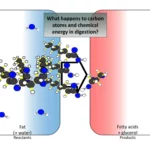Understanding the relationship between meters and angstroms is crucial for navigating the vast scales of the universe, from everyday objects to the intricate world of atoms. This comprehensive guide provides a clear and concise explanation of these units, their conversion, and their significance in various scientific fields.
Bridging the Gap: Meters and Angstroms
We encounter meters daily – measuring room dimensions or a tree’s height. But when we venture into the realm of atoms, we need a much smaller ruler: the angstrom. One angstrom (Å) is a mere one ten-billionth of a meter (10-10 m). Imagine slicing a meter stick into ten billion equal pieces – one slice represents a single angstrom. This tiny unit allows us to explore the distances between atoms and the wavelengths of light, opening a window into the microscopic world.
Converting Meters to Angstroms: A Simple Calculation
Converting between meters and angstroms is straightforward. Multiply the number of meters by 1010 to get the equivalent value in angstroms. For example, a sheet of aluminum foil 0.0001 meters thick is equal to 1,000,000 angstroms. This conversion highlights the dramatic difference in scale between these units. Need a quick conversion? Online tools like CalculateMe.com and ConvertUnits.com can help.
Why Angstroms Matter: Real-World Applications
Angstroms play a vital role across various scientific disciplines:
Atomic Dimensions
In atomic physics, angstroms define atomic sizes. The hydrogen atom, the smallest of all, has a radius of approximately 0.53 Å. Using meters for such measurements would be impractical, resulting in unwieldy decimal values. Angstroms provide a much more manageable scale.
Light Wavelengths
Angstroms are used to describe the wavelengths of visible light (4000-7000 Å). Each color corresponds to a specific wavelength within this range. For example, red light has a longer wavelength (~7000 Å) than violet light (~4000 Å). Did you know that the liquid form of glass, also known as natrium silicate, has unique optical properties related to light wavelengths?
Crystallography
In crystallography, angstroms measure the distances between atoms within crystal lattices, revealing the structural arrangements that give rise to the diverse shapes of crystals.
Angstroms, Nanometers, and Meters: A Spectrum of Scales
While the angstrom remains relevant, particularly in specific fields like optics and crystallography, the nanometer (nm), equal to 10 angstroms (10 Å = 1 nm), has gained prominence, especially in nanotechnology. However, understanding the relationship between all three units – meters, nanometers, and angstroms – provides a comprehensive understanding of length scales.
| Unit | Value in Meters | Example |
|---|---|---|
| 1 Å | 10-10 m | Approximate diameter of a hydrogen atom |
| 10 Å (1 nm) | 10-9 m | Roughly the size of a water molecule |
| 100 Å | 10-8 m | Diameter of a small protein |
| 1000 Å (10 nm) | 10-7 m | Thickness of a cell membrane |
Beyond Conversions: Exploring the Ultra-Small
Ongoing research continually pushes the boundaries of our understanding of the atomic world. While the angstrom remains a valuable tool, advancements may lead to even more precise methods of measurement. Some scientists are exploring the limitations of using angstroms, especially when studying dynamic systems at the atomic scale. And while you’re exploring the intricacies of the micro-world, did you know the pale gas mnemonic can be a helpful tool when studying atomic structures and elements?
Visualizing the Difference
Imagine shrinking a meter stick down to the size of a single atom. The width of that atom would roughly correspond to one angstrom. This illustrates the mind-boggling difference in scale.
A Legacy of Measurement
The meter, originating during the French Revolution, was initially defined as one ten-millionth of the distance from the North Pole to the Equator. The angstrom, named after 19th-century Swedish physicist Anders Jonas Ångström, reflects his pioneering work in spectroscopy.
The conversion between meters and angstroms is more than just a mathematical exercise; it bridges the macroscopic and microscopic worlds, allowing us to comprehend the fundamental building blocks of the universe. While our knowledge continues to evolve, the angstrom remains a valuable tool in our exploration of the incredibly small.
- Unlocking Francis Alexander Shields’ Finance Empire: A Comprehensive Biography - July 12, 2025
- Unveiling Francis Alexander Shields: A Business Legacy - July 12, 2025
- Francis Alexander Shields’ Business Career: A Comprehensive Overview - July 12, 2025















